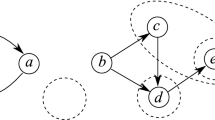Abstract
The concept of anti-link is defined (an anti-link consists of two occurrences of the same literal in a formula), and useful equivalence-preserving operations based on anti-links are introduced. These operations eliminate a potentially large number of subsumed paths in a negation normal form formula. Those anti-links that directly indicate the presence of subsumed paths are characterized. The operations have linear time complexity in the size of that part of the formula containing the anti-link.
The problem of removing all subsumed paths in an NNF formula is shown to be NP-hard, even though such formulas may be small relative to the size of their path sets. The general problem of determining whether there exists a pair of subsumed paths associated with an arbitrary anti-link is shown to be NP-complete. Additional techniques that generalize the concept of pure literals are introduced and are also shown to eliminate redundant subsumption checks. The effectiveness of these techniques is examined with respect to some benchmark examples from the literature.
Similar content being viewed by others
References
Beckert, B., Hähnle, R., Ramesh, A., and Murray N. V.: On anti-links. in F. Pfenning (ed.), Proc. 5th Int. Conf. on Logic Programming and Automated Reasoning (LPAR), Kiev, Ukraine, LNCS 822, Springer, 1994, pp. 275–289.
Breitbart, Y., Hunt, H. B., and Rosenkrantz, D.: On the size of binary decision diagrams representing Boolean functions, Theor. Comp. Sci. 145(1–2) (1995), 45–70.
Bryant, R. E.: Graph-based algorithms for Boolean function manipulation, IEEE Trans. on Computers C-35(8) (1986), 677–691.
Coudert, O. and Madre, J.-C.: A new graph based prime computation technique, in T. Sasao (ed.), Logic Synthesis and Optimization, Chapter 2, Kluwer, Norwell, MA, 1993, pp. 33–58.
de Kleer, J. and Williams, B.: Diagnosing multiple faults, Art. Intelligence 32(1) (1987), 97–130.
de Kleer, J., Mackworth, A. K., and Reiter, R.: Characterizing diagnoses and systems, Art. Intelligence 56(2–3) (1992), 197–222.
de Kleer, J.: An inproved incremental algorithm for computing prime implicants, in Proc. AAAI-92, San Jose, CA, 1992, pp. 780–785.
Grossi, R.: On finding commont subtrees, Theor. Comp. Sci. 108(2) (1993), 345–356.
Jackson, P. and Pais, J.: Computing prime implicants, in Proc. 10th Int. Conf. on Automated Deduction (CADE), Kaiserslautern, Germany, LNCS 449, Springer, 1990, pp. 543–557.
Jackson, P.: Computing prime implicants incrementally, in Proc. 11th Int. Conf. on Automated Deduction (CADE), Saragota Springs, N.Y., LNCS 607, Springer, 1992, pp. 253–267.
Kean, A. and Tsiknis, G.: An incremental method for generating prime implicants/implicates, J. Sym. Computation 9(1990), 185–206.
Kean, A. and Tsiknis, G.: Assumption based reasoning and clause management systems, Comp. Intelligence8(1) (1992), 1–24.
Letz, R., Schumann, J., Bayerl, S., and Bibel, W.: SETHEO: A high-performance theorem prover, J. Auto. Reas.8(2) (1992), 183–212.
Mozetič, I. and Holzbaur, C.: Controlling the complexity in model-based diagnosis, Ann. Math. Art. Intelligence 11(1994), 297–314.
Murray, N. V. and Rosenthal, E.: Inference with path resolution and semantic graphs, J. ACM 34(2) (1987), 225–254.
Murray, N. V. and Rosenthal, E.: Path dissolution: A strongly complete rule of inference, in Proc. 6th Nat. Conf. Art. Intel., Seattle, WA, 1987, pp. 161–166.
Murray, N. V. and Rosenthal, E.: Dissolution: Making paths vanish, J. ACM 48(3) (1993), 504–535.
Ngair, T.-H.: A new algorithm for incremental prime implicate generation, in Proc. IJCAI-93, Chambrey, France, 1993.
Przymusinski, T. C.: An algorithm to compute circumscription, Art. Intel. 30(1989), 49–73.
Ramesh, A. and Murray, N. V.: Non-clausal deductive techniques for computing prime implicants and prime implicates, in Proc. 4th Int. Conf. on Logic Programming and Automated Reasoning (LPAR), St. Petersburg, Russia, LNCS 698, Springer, 1993, pp. 277–288.
Ramesh, A. and Murray, N.: An application on non-clausal deduction in diagnosis, in Proc. 8th Int. Symp. on Artificial Intelligence, Instituto Tecnológico y de Estudios Superiores de Monterrey, Monterrey, Mexico, 1995, pp. 378–385.
Sasao, T.: Logic synthesis with EXOR gates, in T. Sasao (ed.), Logic Synthesis and Optimization, Chapter 12, Kluwer, Norwell, MA, 1993, pp. 259–286.
Slagle, J. R., Chang, C.-L., and Lee, R. C. T.: A new algorithm for generating prime implicatns, IEEE Trans. Comp. C-19(4) (1970), 304–310.
Author information
Authors and Affiliations
Rights and permissions
About this article
Cite this article
Ramesh, A., Beckert, B., Hähnle, R. et al. Fast Subsumption Checks Using Anti-Links. Journal of Automated Reasoning 18, 47–83 (1997). https://doi.org/10.1023/A:1005711712356
Issue Date:
DOI: https://doi.org/10.1023/A:1005711712356




